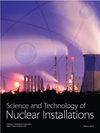A Data-Driven Fault Prediction Method for Nuclear Power Systems Based on End-to-End Deep Learning Framework
IF 0.9
4区 工程技术
Q3 NUCLEAR SCIENCE & TECHNOLOGY
引用次数: 0
Abstract
With the increase in system complexity and operational performance requirements, nuclear energy systems are developing in the direction of intelligence and unmanned, which also requires a higher demand for its safety so that intelligent fault diagnosis and prediction have become a technology that nuclear power plants need to develop at present. At the same time, due to the rapid development of deep learning technology, it has become a meaningful development direction to predict the fault state of nuclear power plants within the framework of supervised deep learning. Usually, the network structure model used in fault diagnosis and prediction requires professional design, which may cost a lot of time and make it difficult to achieve optimal results. For this purpose, we present an end-to-end deep network for nuclear power system prediction (EDN-NPSP), which can automatically mine the transient features of various detection data in the NPS at the current moment through heterogeneous convolution kernels that can increase the receptive field and then predict the feature evolution results of the NPS in the future through a special deep CNN. The results provide an assessment of the future state of NPS. Based on EDN-NPSP presented in this work, we can avoid complicated manual feature extraction and provide the predicted state directly and rapidly. It will provide operators with useful prediction information and enhance the nuclear energy system fault prediction capabilities.基于端到端深度学习框架的核电系统数据驱动故障预测方法
随着系统复杂性和运行性能要求的提高,核能系统正朝着智能化、无人化的方向发展,这对核能系统的安全性也提出了更高的要求,智能故障诊断与预测已成为目前核电站需要发展的技术。同时,由于深度学习技术的快速发展,在监督式深度学习框架下对核电站的故障状态进行预测已经成为一个有意义的发展方向。通常,用于故障诊断和预测的网络结构模型需要专业的设计,这可能会花费大量的时间,并且难以达到最优结果。为此,我们提出了一种端到端的核电系统预测深度网络(EDN-NPSP),该网络可以通过异构卷积核自动挖掘NPS中当前时刻各种检测数据的暂态特征,增加接收野,然后通过特殊的深度CNN预测NPS未来的特征演化结果。结果提供了对NPS未来状态的评估。基于本文提出的EDN-NPSP,可以避免复杂的人工特征提取,直接快速地提供预测状态。它将为操作者提供有用的预测信息,提高核能系统的故障预测能力。
本文章由计算机程序翻译,如有差异,请以英文原文为准。
求助全文
约1分钟内获得全文
求助全文
来源期刊

Science and Technology of Nuclear Installations
NUCLEAR SCIENCE & TECHNOLOGY-
CiteScore
2.30
自引率
9.10%
发文量
51
审稿时长
4-8 weeks
期刊介绍:
Science and Technology of Nuclear Installations is an international scientific journal that aims to make available knowledge on issues related to the nuclear industry and to promote development in the area of nuclear sciences and technologies. The endeavor associated with the establishment and the growth of the journal is expected to lend support to the renaissance of nuclear technology in the world and especially in those countries where nuclear programs have not yet been developed.
 求助内容:
求助内容: 应助结果提醒方式:
应助结果提醒方式:


